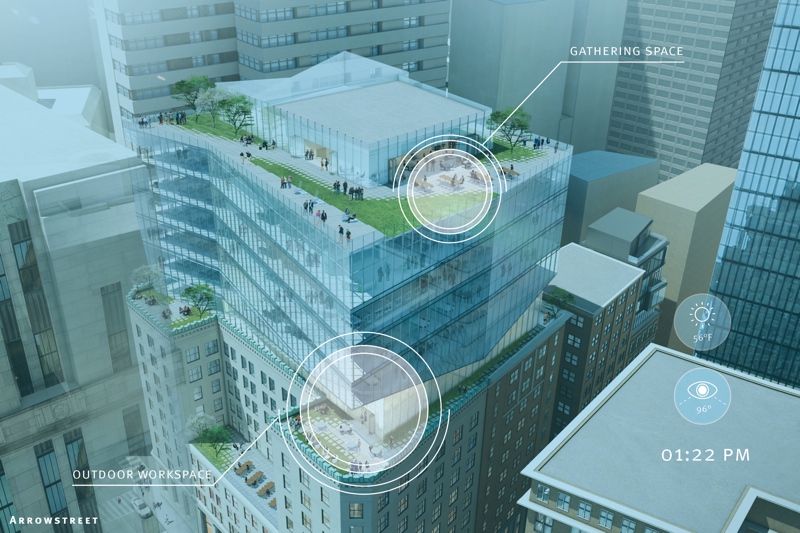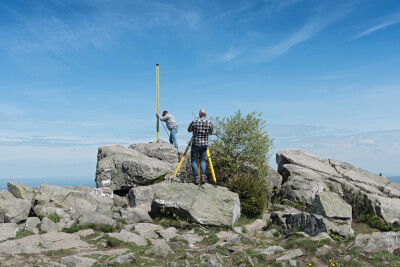One moment I’m in the downtown office of a Boston architecture firm, the next I’m in an alley looking up at a building that doesn’t exist yet. The 3D rendering of the Congress Street project lacks some texture, and the tight alley space means the perspective is slightly skewed, but it still feels uncanny in its realism—and a lot better than any 2D drawing I’ve ever seen.
Arrowstreet’s team is showing me their recent boundary-pushing virtual reality work. I’m seeing firsthand how VR headsets like the Samsung Gear can help clients understand what a design will look like once it’s made the leap from 3D model to the real world.
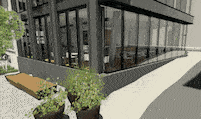
My VR view of the Congress Square project
But that’s only the low-hanging fruit, and the firm has much bigger plans for VR—and its sibling AR—that could mean big changes for AECO. With its in-house coding and development talent, Arrowstreet is building VR and AR applications that will help clients participate in building design in new ways, bring involve GCs earlier than ever before, and even make valuable data available to stakeholders all the way through the management phase.
Arrowstreet is using VR and AR to blur the long-standing lines drawn between architecture, engineering, construction and operation.
Using VR to Shorten the Learning Curve for Design
Kat Schneider, a designer at Arrowstreet, puts on an HTC Vive VR headset and starts exploring the first floor of the hotel the firm is designing for its Congress Square project in Boston. As the team and I watch the VR rendering on a TV, she uses the two controllers to pick up furniture like it’s made of air and move it around the room.
This is the same Revit model as I was looking at earlier, explains principal Amy Korte. “We were thinking of about how you get somebody up into the space in the headset so they understand where to move, what do with some of the controls, what the different buttons mean.” To solve this problem, the team worked up an inspired idea: Schneider picks up a cell phone from a table in the lobby, puts it to her ear, and is transported up to a model of an individual guest room.
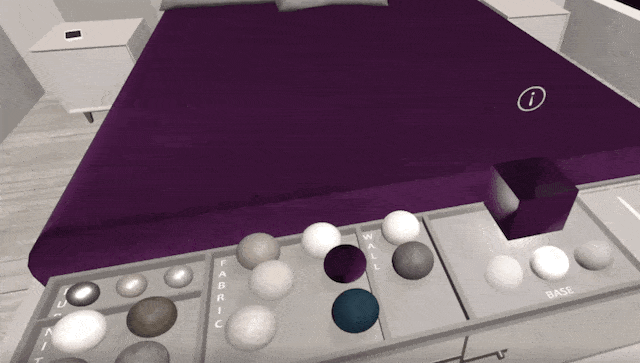
The material changer tool in action
Once inside the guest room, Schneider starts picking up spheres from a table at the foot of the bed, each sphere with a different finish. She throws one at the wall—when it hits, the finish is spread over all the walls in the room.
David Bois, another principal at the firm, tells me that Arrowstreet developed that kind of gesture as a way of bringing the use of VR to the “next level, where you’re actually designing inside the space. So, these were studies for different tools we can use, but we’re hoping to advance that further. So, finding ways to move walls, to adjust space once we design it and have it connected back to the actual model and the documents.”
Kachina Studer, the lead VR developer for Arrowstreet, says that this kind of application will one day make design a much more intuitive process. “There are so many programs out there, and they take so long to learn how to use,” she says. “So we’re bringing it back down to basics, and using all those human actions that won’t need a tool.”
Using VR to Brings Clients into the Design Process
Once VR has made the design process simpler and more intuitive for architects and designers, that raises a question—Does this mean VR can also help other stakeholders participate in the design? Yes, and Arrowstreet is already working on it.
“How do you engage your clients in the design experience?” Korte asks. “We start simple, with moving walls back and forth, giving them that ability to play with it and get into a space at a timeframe that’s longer than our typical client meetings.”
Korte says Arrowstreet has a test project for exporting VR models from Revit to a platform that clients can access. Once there, she says, “they can explore in their own time, they don’t have to be in our office—don’t have to be sitting in a room with five other people watching them.” They can really explore and play with the design in a way they never could before.
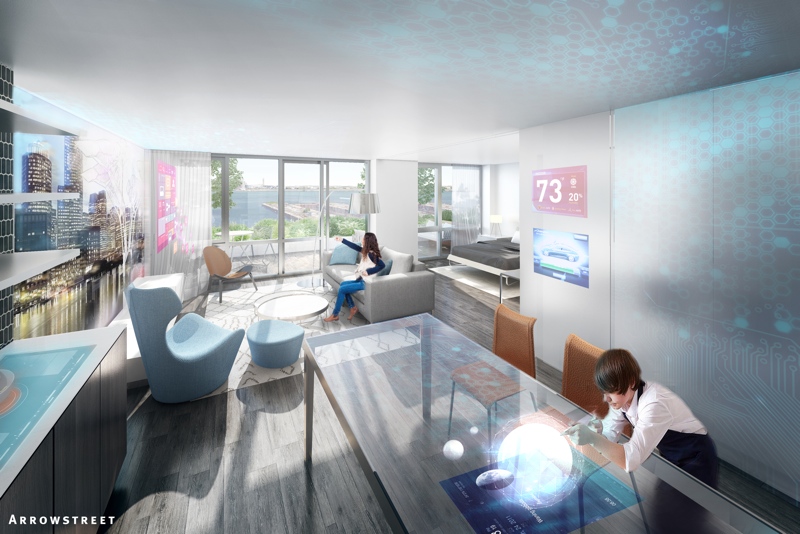
Arrowstreet believes augmented reality will change the way we design and interact with the built environment
Using VR to Bring Contractors into the Design Process
Arrowstreet is finding that VR can do a lot to help the relationship between the design firm and the GC, as well. “What we’re seeing,” says Korte, is that most of the major contractors in Boston are exploring at least virtual reality—if not augmented reality as well—to understand how they can streamline their construction process. For us, that’s where the really interesting relationships start to happen.”
The team tells me that AR and VR are allowing designers and general contractors to start talking much earlier on in the building process. AR and VR give general contractors easy access to the design models, as well as the rich information stored in those models. That means they can help the designers work out pricing issues, logistics, and anything about the design that affects the construct-ability of the building—all before any ground is broken in the field.
“In the past,” says Bois, “we would draw things, and they get bought and go out to the field, and then you would stand with the people in the field to talk about how you achieve the design intent. The hope is to bring that much earlier in the design process, so before it’s bought they have a real sense of what the design intent was, and they can help us execute our design thoughts.”
Korte says the question for Arrowstreet is, “How do we position ourselves so that we’re able to work with GCs in a way that helps our clients get buildings done faster and more cost-effectively?”
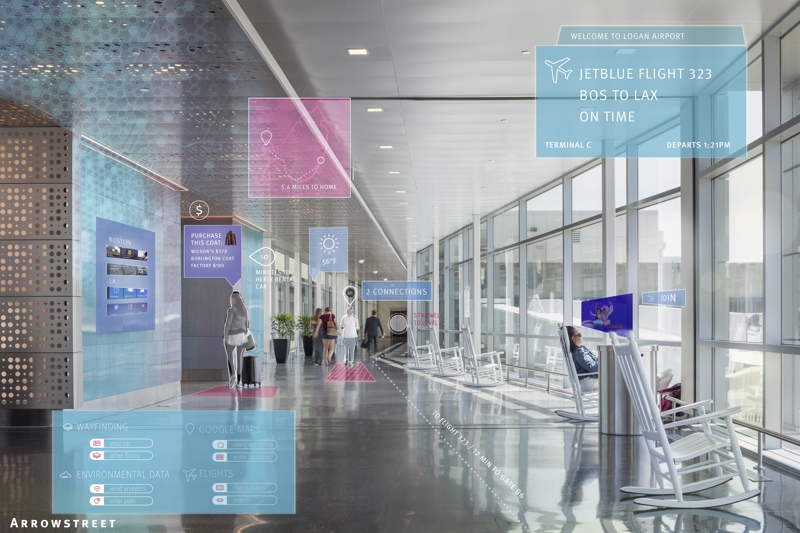
Augmented reality may one day give you access to building information from the original design model
Using VR to Share all the Information in the Model
Here’s where the AR comes in: Bois and Korte say Arrowstreet hopes to port some of their work over to AR, where owners and operations teams can use the 3D models to understand their buildings in ways they couldn’t before.
“We did a project for Massport,” Bois says, “and they’re doing this massive cataloguing of all the buildings in 3D in Revit. However, they’re hampered by the fact that only a few staff members can actually use Revit. So their facilities people—they know the information is there—but they don’t have access to it.”
AR technology represents a chance for anyone to access to the 3D model, regardless of their expertise. Anyone can pop on a HoloLens, look at a pipe, and read the BIM information that pops up.
Arrowstreet is especially excited because this will help them showcase how much information is in the original building model. “You could almost draw the conclusion that hand sketching is to hand modeling as our BIM models are going to be to our VR and AR experiences,” says Schneider. “It gives us the opportunity to show what our models can really do, and we haven’t had the opportunity to do that yet.”
Almost There
Even with a strong vision and serious in-house development talent, Arrowstreet runs into problems with their VR and AR rigs. Lead VR developer Studer can list them readily: The models contain a lot of data, so they can be difficult for the devices to process. The headsets can be heavy, bulky, and sometimes painful to wear. VR and AR present very different design challenges.
Still, Studer notes that none of the challenges are so big that they can’t be solved with a little bit of creative thinking—especially when the future promise of the technology is so great.
“It’s only going to get better,” she says. “We’re not running into too many roadblocks right now. It can only get better from here.”


